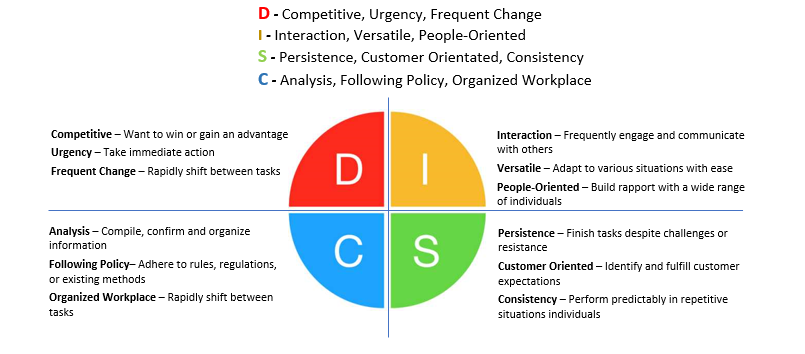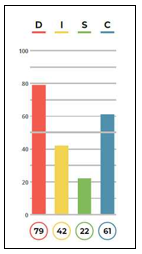A Selection Roadmap: Job Selection and Benchmarking for Success
DISC and Motivators are powerful behavioral model tools to understand yourself and others. They give insight on how to lead, inspire, and best select someone for a role. Selection is 80% of success. Anyone that has ever hired for a position knows the cost of a bad hire in terms of time, energy, and money. Being able to make smarter hiring decisions over time allows us to have the team to leverage the key activities and communications needed to produce the results we want.
In this article, we will explore how the benchmarking conversation starts and how it allows you to select the people best fit for the role. For example, if you hire an extroverted accountant or an introverted salesperson, it is unlikely long-term that those roles will self-reenforce their nature. Hiring those whose nature is self-reinforced by the role makes it a win-win.
The Benchmarking Initial Strategy Session:
During our initial discussion of benchmarking, we will explore the role, key activities, and communications required to produce the results needed for the role. Having a solid job description, or at least a list of required day-to-day activities, and week-to-week is key. A great way to start this conversation is to think…
When they arrive at work Monday at 9 a.m., what activities will they engage in from that start time until 5 p.m. on Friday?
Then, referring to the 12 behaviors of the 4 DISC styles will help us establish our benchmark. Over time as more hires are made for this role, and more candidates come through, there will be reference points to build upon and improve the benchmark on each hire you to make. A well-trained and skilled leader can always look back and find something they learned from each hire that did or didn’t work.
Note: The benchmark cannot be more than 1/3 of your hiring process decision-making criteria. For example, their resume, interview, group interview, prior experience, and education could be other factors to ensure it is no more than 1/3 of the decision.
DISC, Behaviors and Benchmarking
The 12 behaviors relating to the 4 DISC styles are listed below. Please remember the words can sometimes become our label and, therefore, our experience; referencing the definition ensures proper understanding and context for each behavior listed.

Primary Behaviors – The Top 4
In any role, the first four behaviors are the primary and most required. What behaviors are used 75-80% of the time in 1 week? The 80-20 rule is a good rule to use here. In any role, the behaviors eventually cluster around the top four and maybe the next two.
Avoid trying to integrate all 12 behaviors. It’s like trying to find a unicorn. You want to align the role with a person’s natural style and potential, allowing everyone to do what they do best with the proper training and development. This way, the role reinforces the behaviors a person does naturally.
For example, if the role calls for meeting a wide range of new people and building rapport with them, a person with a high “I” behavioral style will naturally seek out people to interact with and new people to develop rapport with. The behaviors of People-Oriented and Interaction would be key to this role. Someone who had these behaviors in their situational and indifferent behaviors might likely be better suited for a different type of role. “I” energy will bring new people in with their warmth, optimism, and trust. When our natural style and behaviors required for the job are aligned, our potential for success increases because we are compelled to engage in the activities the role calls for – it’s our nature and who we are.

Situational Behaviors – The Middle 4
Situational behaviors are useful at times but not in the role all the time. These might not be used day-to-day, but possibly more week-to-week or month-to-month.
Indifferent Behaviors – The Final 4
The bottom four behaviors are indifferent to the role, meaning they don’t matter much to the position. Sometimes the opposite to the primary activities the job calls for day-to-day or maybe only necessary a small percentage of the time like week-to-week, once or twice a month, or quarterly.
Putting Behaviors in Context
We cannot be all things, to all people, all the time. Some roles may require different behaviors, and at times we all need to adapt. No one’s behavior style is an excuse for poor behavior or not learning necessary skills such as organization or communication. When looking at the behaviors that best align for someone in your open role, which behaviors would you choose to get the key accountabilities and outcomes from the position you are looking at?
Which behaviors will lead to satisfying the results best?
For example, a person could be great at analysis, organization, and following policies. However, if the role involves primarily generating new leads, sales, meeting new people, being versatile in changing situations, and building rapport, the person will not likely be a fit for that specific role, but a different role where they can excel with those key behaviors.
Pairing behaviors to their roles are key. Choosing someone for a position with behaviors that do not match their strengths, and forcing them to adapt constantly, will lead to their natural behaviors pulling them in a different direction. This decision can be harmful to the employee and the position. It also keeps you in a constant management state because they are not naturally inclined to do what the role calls for. This situation leaves you to constantly check in on their performance to see if they are on track. Aligning people to their potential allows you to lead and inspire instead of managing and controlling. With the proper leadership, training, and development, their potential can be realized. Turning potential into results is the purpose of leadership.
For additional strategies on how to establish your benchmark, click here.



